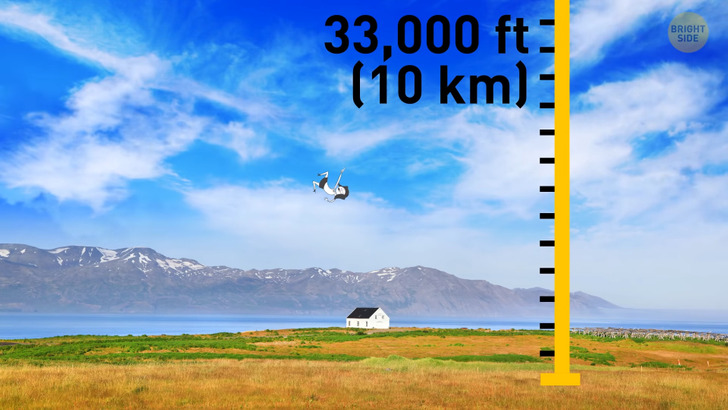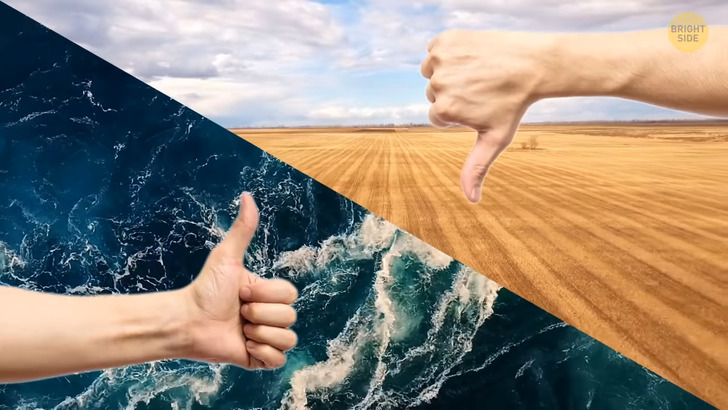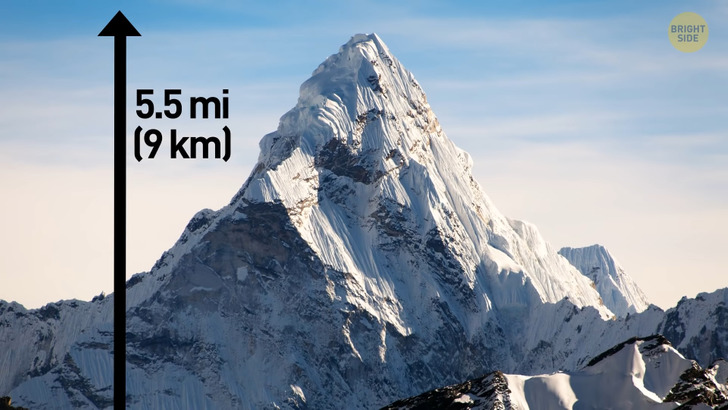My Husband Forbade Me from Buying My Daughter a Gift — Because “It’s HIS Money”

Yep, I think it’s safe to say that falling from any height can be really dangerous, but especially when you’ve tumbled out of a plane! And worse, without a parachute. Now, the trick here is to create drag to slow your descent, use your shirt, pants, or do an air snow angel. Anything to slow you down a little bit! But hey, you’ve always wanted to make an impact, right.

Well check this out: A Yugoslavian woman was working as a flight attendant. She survived an incredible fall on January 26, 1972, after the plane she was working on exploded. Falling from a height of 33,000 feet, she managed to survive but spent the next year and a half recovering after waking up from her coma.
Experts disagree on the right way to land, but there’s definitely a wrong way. Landing on your head! Do you remember the rule of 3 for us squishy human beings? Oh, that’s you and me by the way. 3 minutes without oxygen, 3 days without water, 3 weeks without food. It’s a great guideline, but some people manage to stretch it out a bit further. If watching a sunset, smelling flowers, or ordering that big juicy hamburger is important to you, well, you’d better start thanking that delightful gas oxygen. Don’t believe me? Try doing even one of those things without it!
2 minutes without oxygen will cause the average human to pass out. After 10 minutes, well, there isn’t usually a comeback tour. This varies of course from person to person, depending on their fitness levels, but we love to push the boundaries as humans, don’t we? The longest someone held their breath for was an outstanding 24 min, 3.45 seconds! Give or take. That’s 100 times longer than the first airplane flight! Take that Wright brothers!

Aleix Segura Vendrell from Spain pushed the limits of breath holding in 2016 by floating in a controlled pool environment. Just before going under he was gulping in air like a fish to try to get as much oxygen as possible! Strangely, holding your breath underwater is easier than trying on dry land! Swimming activates your divers reflex, slowing down our heart rate and metabolism.
Not only is oxygen important, so is precious H2O and tasty food! Each cell in our body needs water to survive. If we can’t replace the water loss quickly, we only have about 3 days to a week before it’s all over! How humid the air is, our age, physical activity and health play a huge part in water retention in our bodies. When we’re running low on water, the important areas of our body, like the heart and brain, pull water from wherever it can. Like a sponge, these organs soak up everything, until there’s nothing left!
In 1979, an Austrian man in a holding cell lasted 18 days without water! He allegedly licked condensation off the prison walls to stay hydrated! What’s the scariest thing in the universe? The fridge is empty! Where’s all the food? Without any calories, your body starts to feed...on itself! Not exactly the diet I had planned for this year! During the first few days, our carbohydrate reserves are turned into glucose. When that’s all used up our body starts to target fat, muscle, and other proteins... all the way down to the bones!

Fasting is a common way to let our bodies use those extra reserves inside of us! Mahatma Gandhi’s longest of many fasts lasted 21 days! The longest known fast was when a 27-year-old lived off water and vitamin supplements for 382 days and shrank from 456 to 180 pounds! Yow! 180 lb Our bodies are equipped to survive without food for long periods, our ancestors didn’t exactly have a supermarket to go to! This makes us pretty good at dealing with starvation.
We humans can cope with many extreme survival situations, but how long can you swim in freezing water without turning into a popsicle? What happens if you’re stuck in the desert? Or at the top of a mountain? Climbing the peaks of the world, like the Rocky Mountains, the Swiss Alps or even Mount Everest is challenging on a good day, but the real danger is altitude sickness!
It affects about half of all climbers, starting at roughly 1 and a half miles up, the lack of oxygen can cause dizziness, tiredness, and headaches for some. Others can even get insomnia! This is just the start of a whole bunch of symptoms that affect our bodies! Consciousness becomes a big problem for most people at 3 miles up, without proper preparation. Ascending too quickly can even lead to fluid in your lungs, or even worse!

The thing about altitude sickness is that it doesn’t care if you’re old or young, male or female, a couch potato or an athlete! Everest is 5 and a half miles high and the ultimate challenge for climbers. That’s like hiking up 20 Empire State buildings, or 2 times the Hollywood Walk of fame! Austrian Felix Baumgartner pushed the altitude tolerance limit on Oct. 14, 2012. He jumped from 128,000 feet up... that’s nearly 24 MILES! It’s no surprise that he’s also the first skydiver to go faster than the speed of sound, reaching a mind-boggling 833 mph!
He definitely had the right equipment, like a pressure suit with oxygen, and safety checks in place, which goes to show you... If you’re going up high remember the 5 Ps. Proper Planning Prevents Poor Performance! Surviving extreme heat isn’t just about the temperature. Humidity is the real danger to us! The less humid the air is, the more water stays where it belongs... in our body.
Ever walked into the sauna and realized that it’s over 230 degrees! That’s so hot and humid, you’d probably only last about 3 to 4 minutes max! Wait, humans can’t melt... right? Above 104 degrees, there’s a real chance of heatstroke! It doesn’t sound like a big change from our usual body temperature, but it is. Just imagine getting caught in a desert for a few days, and not just any desert. The world’s hottest! The hottest temperature ever recorded on Earth was in Nevada. A crazy 134 degrees!

Cooling way down, really quickly, can help relieve cramps, headaches, and even nausea. But breathing can become kinda impossible once your organs start to shut down and hypothermia sets in. As soon as our bodies drop below our natural body temperature, our muscles start to stiffen. That’s why you stop feeling cold and pain after a while, there just aren’t any nerve endings functioning anymore.
Shivering quickly to produce heat is our body’s natural way to keep our organs warm! This only works for cold air though. In cold water, shivering drains your body heat even faster. If you’ve never heard of the 300 club, you’re not alone. A base in Antarctica has found a great way to test the extreme limits of the human body in the most peculiar way.
Participants at the station warm up in the sauna, which is heated to 200 degrees. Then they pull on their boots and run outside... where it’s −100! Not only do they have to endure the 300-degree temperature change, but they’ve also got to run around the South Pole before coming back to the sauna to warm up again! — yawn yawn yawn...am I tired! Time for a little snooze!
Sleep is very important, maybe that’s why getting out of bed in the morning is so tough! We need sleep to recharge our body from the long day we’ve just had... leaving us refreshed and alert when we hear that alarm. Our brain can turn all fuzzy without enough sleep, and a good 8 hours is perfect for a healthy immune system. Sleeping improves our memory, our heart and puts us in a better mood for the day!

Randy Gardner and his friends decided to test the limits of staying awake. It was for their science fair project. They managed to stay awake and functioning for 11 days and 25 minutes! Even when tested during and after the experiment, Randy could play basketball and had no abnormal brainwaves!
Now, it’s almost impossible to calculate the exact G-force that would harm a human. That’s because there are 3 types of G-force out there. Side to side, Up and Down and Forward and backward! The danger lies in how long we have to sit there while we’re being thrown around like a rag doll. The longer we sit there, the more it affects our bodies.
We experience G-force at home, simply by sitting down on the couch too quickly, sneezing, or having someone slap our back a little too hard! Pilot John Stapp demonstrated that a human can withstand over 40 G’s! That’s nearly 10 times the amount an average racing driver feels! The experiment only went on a few seconds, but for an instant, his body weighed almost 7,000 pounds! Survival isn’t always about taking on the elements. Sometimes, it’s fighting against time!
The current record for the longest living human is Jeanne Calment, who was born in 1875! Jeanne lived till the ripe age of 122 years and 5 months.











